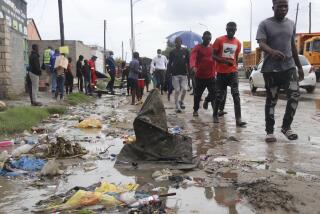Zaire Coffins Sealed to Stop Disease : Medicine: Mourners are warned not to touch bodies of victims of Ebola virus. U.S. experts arrive to begin containment work.
- Share via
KIKWIT, Zaire — Fear of contagion laced the grief of relatives who kept their death watch Friday in a cemetery where authorities handed over victims in coffins sealed to stop the spread of a dreaded virus.
Two small boys in the crowd of about 50 people pulled T-shirts over their faces in a misguided attempt to protect themselves from the deadly Ebola virus that swept through Kikwit.
A sealed coffin arrived from the fenced-in hospital 100 yards away, and the boys, who were carrying palm fronds, were warned not to wash or touch the body as their African traditions demand.
Medical experts from the U.S. Centers for Disease Control and Prevention arrived in Kikwit from Atlanta on Friday to begin work to contain the virulent disease. A group of journalists, who had received permission from the Zairian government, accompanied the doctors on their flight to the city of 600,000.
Kikwit, a sprawling hodgepodge of concrete-block houses set in lush green savannah, is the scene of the first major outbreak of the Ebola virus in 16 years.
Dozens of people have died in recent weeks from the disease, which starts like malaria with headache and fever. Then the diarrhea and vomiting begin. Death comes within days in 80% of cases as blood pours from the victims’ bodies, streams of red slipping from their eyes, ears and noses.
There is no vaccine or cure.
About 20 people--infected patients and hospital staff exposed to the virus--were inside the 350-bed hospital where the epidemic began and which has been cleared out to keep the virus from spreading.
The hospital, painted a bright blue, has been under quarantine like the rest of Kikwit since early this week.
But there are no guards or soldiers posted around it, and one microbiologist said he was terrified that the virus would spread like wildfire because people were sneaking into the hospital to visit their dying loved ones, possibly carrying the virus with them when they leave.
The microbiologist, Prof. Jean Jacques Muyembe of the University of Kinshasa, disagrees with officials from the World Health Organization and the medical aid group Doctors Without Borders, who say the virus was caught early enough to be contained without causing a huge death toll.
Asked how many deaths he anticipated, Muyembe replied: “A lot.”
Muyembe was in the village of Yambuku when the Ebola virus was first isolated there in 1976.
“The difference is, Yambuku is in a forest with a sparse population,” he said in Kikwit. “This is more serious because it is in a city of a half a million. The possibility of expansion is tremendous.”
The number of deaths has been difficult to confirm because of conflicting reports and the uncertainty that Ebola was the cause of all the deaths.
The WHO said late Friday that 48 people are known to have died from Ebola, and 17 more are hospitalized.
Nearly two-thirds of the victims worked in the hospital, including three Italian nuns ministering to the poor in Kikwit.
Most of the confirmed Ebola cases were in Kikwit, with one case each in the villages of Mosango and Yassa Bonga, he said.
Health experts were trying to determine whether the disease had spread to a third village, Kenge, about halfway between Kikwit and the capital, Kinshasa, 370 miles to the west.
(BEGIN TEXT OF INFOBOX / INFOGRAPHIC)
Containing a Virus
The Zairian government has created a quarantine zone 120 miles wide around the town of Kikwit to contain the first major outbreak of the deadly Ebola virus in 16 years. The government also shut down clinics, schools and air traffic in and out of Kikwit.
More to Read
Sign up for Essential California
The most important California stories and recommendations in your inbox every morning.
You may occasionally receive promotional content from the Los Angeles Times.













